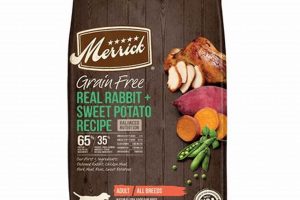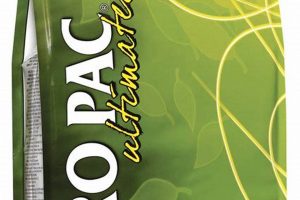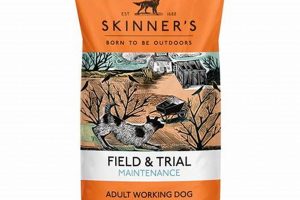Nutritionally dense products designed to increase body mass in canines are commercially available. These items typically feature a higher caloric content and an elevated percentage of protein and fat compared to standard maintenance diets. A veterinarian-recommended, high-calorie kibble, for example, could be used to support a dog recovering from illness or surgery.
Maintaining a healthy weight is crucial for overall canine well-being. Deliberately increasing caloric intake, under veterinary guidance, can be beneficial for underweight dogs. This approach can assist in regaining muscle mass and improving energy levels, contributing to a better quality of life. Historically, supplemental feeding has been utilized to aid working dogs, such as sled dogs, during periods of high energy expenditure.
The following sections will detail the various factors to consider when selecting appropriate nutritional support for canines needing to gain body mass, including ingredient considerations, feeding strategies, and potential health implications.
Guidance on Nutritional Support for Underweight Canines
The following recommendations offer practical advice on selecting and implementing strategies to promote healthy weight gain in underweight canines. Adherence to these guidelines, in consultation with a veterinarian, can help ensure the safety and efficacy of the process.
Tip 1: Consultation with a Veterinarian. A veterinary assessment is paramount to identify underlying medical conditions contributing to weight loss. The veterinarian can rule out diseases and provide tailored dietary recommendations.
Tip 2: Gradual Introduction of Calorie-Dense Food. Abrupt dietary changes can lead to gastrointestinal upset. A slow transition to the enhanced caloric food is essential. Start by mixing small amounts of the new formulation with the current diet, gradually increasing the proportion over several days.
Tip 3: Select High-Quality Protein Sources. Protein is crucial for muscle development. Opt for options with named meat sources as the primary ingredient, such as chicken, beef, or fish. Avoid formulations listing generic “meat by-products” without specifying the source.
Tip 4: Incorporate Healthy Fats. Fats provide concentrated energy. Include sources of omega-3 and omega-6 fatty acids, such as fish oil or flaxseed oil, to support overall health and promote healthy skin and coat.
Tip 5: Monitor Body Condition Score. Regularly assess the dog’s body condition score (BCS) using a standardized chart. This allows for objective tracking of progress and enables adjustments to the feeding plan as needed. Aim for a gradual improvement toward the ideal BCS.
Tip 6: Frequent, Smaller Meals. Instead of one or two large meals, provide several smaller portions throughout the day. This can improve digestion and nutrient absorption, particularly in dogs with sensitive stomachs or reduced appetites.
Tip 7: Weigh Regularly. Consistent weight monitoring, using a reliable scale, provides quantifiable data to assess the effectiveness of the nutritional intervention. Record weight changes to identify trends and make informed decisions regarding adjustments to the feeding regimen.
Tip 8: Consider Palatability Enhancers. If the dog is a picky eater, adding palatable elements such as low-sodium broth or a small amount of cooked, lean meat may improve acceptance of the food. Always prioritize nutritional value over mere palatability.
Implementing these strategies requires careful observation and consistent monitoring. The ultimate goal is to facilitate healthy weight gain while ensuring the dog’s overall well-being and preventing complications.
The subsequent sections will explore additional strategies for optimizing nutrient absorption and addressing potential challenges in the weight gain process.
1. Caloric Density
Caloric density, expressed as kilocalories per unit of weight (e.g., kcal/kg or kcal/cup), is a primary determinant of a food’s capacity to promote weight gain. Specifically in the context of canine nutrition, it is the foundational property upon which “weight gain food for dogs” is predicated. A food with a higher caloric density provides more energy in a smaller volume, facilitating increased energy consumption without necessitating a substantial increase in food quantity. This is particularly relevant for dogs with reduced appetites or limited digestive capacity, as the ability to ingest a sufficient number of calories is often a limiting factor in weight restoration.
The relationship between caloric density and weight gain is direct: a greater caloric intake, exceeding expenditure, results in weight accumulation. To illustrate, a standard maintenance canine diet might provide 350 kcal per cup, whereas a food designed for weight gain might contain 500 kcal per cup or more. This seemingly small difference becomes significant over time. If a dog requires 1000 kcal daily to gain weight, it would need to consume approximately 2.85 cups of the maintenance diet, compared to only 2 cups of the calorie-dense formula. In practical terms, this reduces the burden on the dog’s digestive system and increases the likelihood of successful weight gain.
In summary, caloric density is a core attribute of formulations intended to induce weight restoration in dogs. It addresses the fundamental need to increase energy intake, particularly when dealing with animals that have diminished appetites, digestive inefficiencies, or heightened metabolic demands. However, the strategic selection of calorie-dense foods should always be coupled with veterinary guidance to ensure that the chosen formulation aligns with the dog’s specific health status and nutritional requirements, preventing potential complications related to improper nutrient balance or pre-existing conditions.
2. Protein Source
The protein source within canine diets formulated to promote weight gain is a critical determinant of their effectiveness. The amino acid profile of the protein directly influences muscle protein synthesis, a key process in increasing lean body mass. High-quality protein sources, such as chicken, fish, or beef, contain a complete array of essential amino acids necessary for this synthesis. Conversely, lower-quality protein sources, often derived from plant-based ingredients or rendered by-products, may lack sufficient quantities of one or more essential amino acids, thereby limiting muscle development, even with adequate caloric intake.
The practical significance of selecting a high-quality protein source is evident in the outcomes of nutritional interventions. A dog recovering from surgery, for example, requires increased protein intake to repair damaged tissues and rebuild muscle mass lost during convalescence. If the diet is deficient in essential amino acids, the body may catabolize existing muscle tissue to meet its protein requirements, counteracting the intended goal of weight gain. Another illustrative case is that of working dogs, such as those involved in herding or agility, whose muscular development and performance are directly influenced by dietary protein quality. A diet rich in bioavailable protein supports muscle strength and endurance, contributing to optimal physical condition.
In conclusion, the quality and source of protein are fundamental considerations in formulating a “weight gain food for dogs.” A superior protein source, replete with essential amino acids, is essential for maximizing muscle protein synthesis and achieving sustainable weight gain. Ignoring the protein source can lead to suboptimal results, potentially undermining the entire nutritional strategy. Veterinary guidance is essential in selecting the most appropriate protein source, considering individual canine needs and potential sensitivities.
3. Fat Content
Fat content in canine diets designed for weight gain is a critical factor due to its high caloric density and role in nutrient absorption. Understanding the different facets of fat content is essential for selecting appropriate nutritional support for underweight animals.
- Caloric Density of Fat
Fat provides more than twice the calories per gram compared to carbohydrates or protein. This concentrated energy source is essential in increasing overall caloric intake without dramatically increasing food volume, which is beneficial for dogs with poor appetites or limited digestive capacities. For instance, a diet with a fat content of 18% will provide significantly more energy than one with only 8% if all other factors remain constant.
- Essential Fatty Acids
Fats are a primary source of essential fatty acids, such as omega-3 and omega-6 fatty acids, which are vital for maintaining healthy skin, coat, and immune function. Deficiencies in these fatty acids can lead to skin problems and reduced immune response, which can hinder the weight gain process. Incorporating sources like fish oil or flaxseed oil ensures these essential nutrients are present.
- Digestibility and Absorption
The digestibility of fats influences how efficiently a dog can utilize the energy provided. Highly digestible fats, such as those from animal sources, are more readily absorbed compared to some plant-based fats. Efficient absorption of fats ensures that the increased caloric intake translates into actual weight gain. A diet containing poorly digestible fats might lead to gastrointestinal issues and hinder nutrient uptake.
- Palatability and Appetite Stimulation
Fat enhances the palatability of food, making it more appealing to dogs, especially those with reduced appetites due to illness or stress. The flavor and aroma of fats can stimulate appetite, encouraging greater food consumption. Therefore, including sufficient fat content can help ensure that the dog consumes the necessary calories to support weight gain.
The careful consideration of fat contentits caloric density, provision of essential fatty acids, digestibility, and impact on palatabilityis paramount in designing effective “weight gain food for dogs.” A balanced approach, guided by veterinary advice, ensures that the fat content supports weight gain without causing digestive upset or other health complications.
4. Digestibility
Digestibility constitutes a fundamental determinant in the efficacy of “weight gain food for dogs”. Regardless of the caloric density or nutrient profile of a given food, its ability to facilitate weight gain is contingent upon the canine’s capacity to effectively digest and absorb its constituent components. Impaired digestibility compromises nutrient assimilation, rendering the nutritional content functionally irrelevant.
- Enzyme Activity and Nutrient Breakdown
Digestive enzymes, produced by the pancreas and small intestine, catalyze the breakdown of complex molecules into simpler compounds that can be absorbed. Deficiencies or inefficiencies in enzyme production, which may occur due to pancreatic insufficiency or other gastrointestinal disorders, can impede the digestion of proteins, fats, and carbohydrates. Consequently, even if a “weight gain food for dogs” is rich in these macronutrients, a dog with compromised enzyme activity may not be able to efficiently extract them, thus hindering weight gain.
- Gastrointestinal Transit Time and Absorption Efficiency
The rate at which food traverses the gastrointestinal tract influences the duration of nutrient exposure to absorptive surfaces. Abnormally rapid transit time, often associated with diarrhea, reduces the opportunity for nutrient uptake, resulting in malabsorption and impaired weight gain. Conversely, excessively slow transit time can lead to bacterial overgrowth and fermentation, which may also disrupt nutrient absorption. The formulation of “weight gain food for dogs” should consider factors that optimize gastrointestinal transit time, such as fiber content, to promote efficient nutrient assimilation.
- Ingredient Bioavailability and Processing Methods
The bioavailability of nutrients within a food product is influenced by the inherent properties of the ingredients and the methods used to process them. For instance, protein sources that have undergone excessive heat treatment may experience reduced digestibility due to denaturation. Similarly, the presence of antinutritional factors in certain plant-based ingredients can interfere with nutrient absorption. “Weight gain food for dogs” should prioritize highly digestible ingredients that have been processed in a manner that preserves nutrient bioavailability.
- Gut Microbiome Composition and Digestive Health
The canine gut microbiome plays a crucial role in digestion and nutrient absorption. A diverse and balanced microbial population aids in the fermentation of dietary fibers, producing short-chain fatty acids that serve as an energy source for intestinal cells. Dysbiosis, or an imbalance in the gut microbiome, can disrupt digestive processes and impair nutrient uptake. Formulating “weight gain food for dogs” with prebiotics and probiotics can support a healthy gut microbiome and enhance digestive efficiency.
In summary, digestibility is a multifaceted concept that encompasses enzyme activity, gastrointestinal transit time, ingredient bioavailability, and gut microbiome composition. Optimizing these factors is essential for maximizing the effectiveness of “weight gain food for dogs” and ensuring that the intended nutritional benefits are realized. Veterinary consultation is recommended to address any underlying digestive issues that may compromise nutrient absorption and impede weight restoration.
5. Veterinary Approval
Veterinary approval serves as a critical safeguard in the selection and implementation of dietary strategies aimed at promoting weight gain in canines. This endorsement ensures that the nutritional plan aligns with the animal’s specific physiological needs and mitigates the risks associated with inappropriate dietary interventions.
- Individualized Health Assessment
A veterinarian’s assessment accounts for underlying medical conditions that may contribute to weight loss, such as parasitic infections, endocrine disorders, or malabsorption syndromes. Dietary recommendations without such evaluation could exacerbate these conditions, leading to adverse health outcomes. For example, a dog with kidney disease requires a diet with restricted phosphorus and protein levels, which a standard weight gain formula might not provide.
- Nutritional Adequacy and Balance
Veterinary approval verifies that the selected food provides a balanced profile of macronutrients and micronutrients appropriate for the canine’s age, breed, and activity level. An unbalanced diet can lead to nutritional deficiencies or excesses, compromising overall health. An overly high-fat diet, for instance, could lead to pancreatitis, while insufficient protein intake might hinder muscle development.
- Monitoring and Adjustment
Veterinary oversight facilitates the ongoing monitoring of the dog’s response to the dietary intervention, allowing for timely adjustments as needed. Regular check-ups and weight assessments enable the veterinarian to track progress and identify potential complications early on. If a dog develops diarrhea or vomiting after starting a weight gain food, the veterinarian can modify the diet or recommend supportive treatments.
- Drug Interactions and Contraindications
Veterinary approval considers potential interactions between the selected food and any medications the dog is currently receiving. Certain dietary components can affect the absorption or metabolism of drugs, potentially altering their efficacy or toxicity. A dog taking corticosteroids, for example, may require a diet with specific electrolyte adjustments to mitigate the drug’s side effects.
The endorsement of a veterinarian provides assurance that the chosen weight gain food is both safe and effective for the individual canine, considering its unique health profile and nutritional requirements. This collaborative approach maximizes the likelihood of successful weight restoration while minimizing the potential for adverse consequences.
Frequently Asked Questions
The following questions address common concerns and misconceptions regarding the use of specialized diets to increase body mass in underweight dogs. The information presented is intended to provide clarity and promote informed decision-making, in conjunction with veterinary guidance.
Question 1: Is it always necessary to utilize specialized food to achieve weight gain in underweight dogs?
No. In some instances, increasing the quantity of the dog’s current food may suffice. However, if the dog has a poor appetite, digestive issues, or requires a significantly higher caloric intake, a calorie-dense, highly digestible formula may be necessary.
Question 2: Are “weight gain food for dogs” formulations safe for all breeds?
While generally safe, specific formulations may be better suited for certain breeds. Giant breeds, for example, may benefit from diets formulated to support joint health during periods of rapid growth, whereas smaller breeds may require smaller kibble sizes.
Question 3: How quickly should a dog gain weight on a specialized weight gain diet?
Weight gain should be gradual and consistent. A healthy rate of weight gain is typically between 1-2% of body weight per week. Rapid weight gain can lead to digestive upset and other health problems. Regular monitoring is essential.
Question 4: What are the potential risks associated with feeding a dog a diet intended for weight gain?
Potential risks include digestive upset (diarrhea or vomiting), pancreatitis (particularly with high-fat diets), and the exacerbation of underlying medical conditions if the diet is not appropriately formulated. Veterinary oversight is critical.
Question 5: Can homemade diets effectively promote weight gain in underweight dogs?
Homemade diets can be effective, but require careful formulation by a veterinary nutritionist to ensure nutritional completeness and balance. Without proper expertise, homemade diets can easily lead to deficiencies or excesses, jeopardizing the dog’s health.
Question 6: Are there alternative methods to increase a dog’s appetite besides switching to a weight gain food?
Yes. Appetite stimulants, anti-nausea medications, and feeding tube placement are potential alternatives, depending on the underlying cause of the decreased appetite and the dog’s overall health status. These options should be explored in consultation with a veterinarian.
The information provided is intended for informational purposes only and does not constitute veterinary advice. Consultation with a qualified veterinarian is essential before making any dietary changes for an underweight dog.
The next section will delve into specific ingredient considerations for canine weight gain diets.
Conclusion
This article has explored various facets of “weight gain food for dogs,” emphasizing the importance of veterinary guidance, appropriate caloric density, protein quality, fat content, and digestibility. Successful weight restoration requires a comprehensive understanding of the dog’s underlying health status and a strategic approach to dietary management.
The responsible selection and implementation of nutritional strategies are paramount in ensuring the health and well-being of underweight canines. Ongoing research and advancements in veterinary nutrition will continue to refine our understanding of optimal weight management protocols, further enhancing the capacity to support the health of companion animals.







